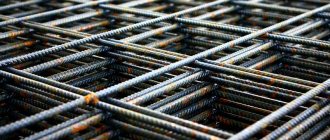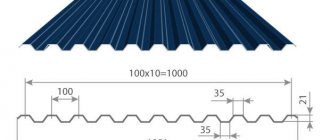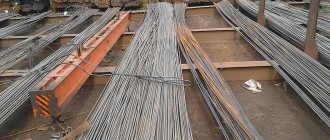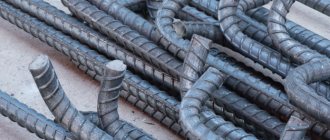Reinforced concrete structures in construction are the strongest, which is why they are used in the construction of house foundations, load-bearing beams and floor slabs, bridges, columns and other critical objects. Without reinforcement, concrete poorly resists tensile and bending loads, which cause its destruction. This problem is solved simply - they “stuff” the concrete with steel rods, which serve as a rigid frame in its body. The reinforcement, the weight of which is necessary for design calculations and determining the required amount of material, can have different shapes and cross-sectional diameters.
Samples of reinforcement of different diameters Source permglavsnab.ru
Why and how to determine the weight of reinforcement
Most private developers wondered how much 12 mm reinforcement weighs per meter - it is what is most often used for pouring foundations, monolithic basement walls, and armored belts. The answer to this helps solve at least two problems.
- Determination of the carrying capacity of the vehicle required to deliver materials to the construction site.
Not all developers use delivery services, and not all small sellers provide such a service. If you don’t need so many rods, it’s cheaper to pick them up yourself, but you need to know whether the load will be excessive for the car. Since the standard length of the reinforcement is 6 or 12 meters, many people cut it in half right on the spot and transport it on a trunk or in a trailer. Or they select short rods from unmeasured lots.
The number of short rods in unmeasured batches can reach 7% Source prom.st
See also: Catalog of companies that specialize in the design and installation of metal structures (canopies, greenhouses, etc.)
- Determination of reinforcement footage in ton.
Large volumes of rolled metal are sold using not meters or pieces as a unit of measurement for calculations, but a ton. If you know how many linear meters of reinforcing bars are contained in one ton, it will not be difficult to calculate the weight required for ordering and purchasing.
In theory, knowing the diameter of the required products and the density of the steel alloy from which they are made, you can independently calculate their weight. But in practice, such calculations will have a large error, since the reinforcement bars do not have a constant cross-section, but a periodic one, with longitudinal and transverse stiffeners. And they have two diameters - minimum and maximum.
Reinforcement cross-section - drawing Source ugmk.com
But there is no need to do this. A table compiled on the basis of GOST 5781-82 will help you find out how much the reinforcement weighs. This document regulates all parameters of these metal products. Their mass depends primarily on their diameter.
- The thinnest rods have a diameter of 6 mm and the weight of one linear meter is slightly more than 220 grams.
- The thickest 80 mm reinforcement is much heavier - more than 39 kg per linear meter.
The larger the diameter and denser the reinforcement pattern, the more important it is to know how much a meter of reinforcement weighs. The mass of the metal frame must be taken into account when calculating the load on the base, and an error can lead to unpredictable consequences.
Class A500S fittings: GOST
To produce high-quality fittings of class A500C, it is necessary to choose the right raw materials and strictly follow the manufacturing technology. The regulatory document for A500S valves is GOST 52544 2006 with requirements for the production process: from the purchase and quality control of raw materials to the delivery of finished products to customers.
Production
According to the 4th part of GOST 52544, for rolling steel in the production of A500C reinforcement, we use the hot-rolled method, which is necessary for the production of thicker and stronger rods. At the time of production, a minimum amount of alloying elements is added to the raw materials, which significantly reduces the price of the finished product.
Marking
The marking of any fittings is a technical passport of the product, which informs about the main properties and characteristics of the raw materials and the finished product. A500C reinforcement stands for thermomechanically processed, high-flow material suitable for welding, where:
- “A” – thermal and mechanical manufacturing method;
- 500 – ultimate fluidity of molten raw materials;
- “C” – possibility of welding elements.
The nominal weight of a linear meter, diameter and cross-sectional area of the rod must correspond to the figures given in GOST in the table of norms for reinforcing bars.
Molding for delivery to the consumer
A500C fittings are supplied to customers in two types:
- Formed into skeins: typical for a rod up to 6 mm in diameter;
- They are cut into bars of the length required by the customer. For rods from 12 mm.
According to GOST, the maximum permissible curvature of reinforcing bars is 0.6% of the length.
Performance characteristics
The operational characteristics of A500C fittings include the following features:
- Increased plasticity: ensured by the low concentration of carbon compounds in the raw material.
- High weldability of metal rods to each other.
- Long service life.
Weight table
In accordance with the current standard, reinforcement of classes A240, A400 and A500C is used in construction. All weight values in 1 linear meter, in a rod 11.75 m long and in 1 ton of timber are summarized in the table. The error is acceptable, but insignificant, no more than a few percent.
Summary table for all diameters Source vezetnerud.ru
Bend radius of A500C reinforcement
The bending radius is the most important point of instructions when using reinforcement in construction. It depends on the cross-section of the reinforcement and its classification. For reinforcement marked A500C, the bend radius is equal to 2.5 rod diameters, and the bend angle cannot exceed 180 degrees.
According to GOST, finished fittings must be checked for quality using one of two methods:
- One-time bend on the mandrel up to 180° in a cold state;
- Bend up to 90° and then bend at an angle of 20°.
The service life of the concrete product will depend on whether the conditions for the bend radius of the A500C reinforcement are met, because the bent rod becomes weaker.
Examples of calculations
To find out how much 1 meter of 12 mm reinforcement weighs, just find this diameter in the first column. The following gives the mass of 1 l.m. – 888 grams. And there are only 1126 meters in a ton, or, if you divide this value by the length of the rod, almost 96 pieces.
The design documentation may only indicate the diameter and weight of the reinforcement without indicating the footage. When purchasing individually, you will have to calculate how many pieces you need. For example, you need to buy 1.5 tons of 16 mm reinforcement to install a strip foundation.
- We find from the table how much 1 meter of reinforcement weighs - it is 1.58 kg.
- We convert 1.5 tons into kilograms, multiplying by 1000 - 1500 kg.
- Divide 1500 by 1.58 and we have 950 m.
- Or divide 1500 by 18.56 (the weight of one bar) and get 81 pieces.
These simple calculations will allow you not only to avoid making mistakes when purchasing, but also to check the amount of material delivered to the site.
When you need to find out how much a certain number of rods will weigh, do the opposite: multiply the weight of the rods of the required diameter by their number or footage. For example, you need to buy 30 rods, the thickness of the reinforcement is 20 mm. With a mass of one rod of 29 kg, the total weight will be 30 x 29 = 870 kg.
Correct reinforcement
Concrete reinforcement is usually carried out using steel bars with a diameter of 8 to 14 mm, although its thickness depends on the overall thickness of the products. The vertical and transverse gratings serve more for bonding than for structural strength.
The main load in problem cases falls on the longitudinal rods, which must be made of ribbed rods.
The prepared mesh with a cell size of 20 or 30 centimeters is placed in the place of pouring into the formwork frame. Typically, two layers of mesh are used, which should fill the entire concreting space, and especially problem areas - the corners of the structure.
The upper and lower gratings are connected to each other with ordinary wire using metal rods. The mesh must be deep in the concrete and not on the surface. The layer of solution above or below the mesh should not be less than 20 mm. This will protect the metal from rapid corrosion and extend the service life of reinforced concrete.
Weight of composite reinforcement
Nowadays, fiberglass reinforcement bars are increasingly being used instead of steel reinforcing bars. They have a lot of advantages, including light weight. In addition, fiberglass has better tensile strength than steel, which allows the use of products with a smaller diameter. For example, an 8 mm composite rod is equivalent in its physical and mechanical characteristics to a 12 mm steel rod. Accordingly, the load decreases even more noticeably.
Table for determining the equivalent diameters of steel and composite reinforcement Source luxkompozit.ru
Compare how much a meter of 12 mm steel alloy reinforcement weighs (890 g) and a meter of fiberglass rod with a diameter of 8 mm (110 g). The difference is 8 times.
Features of the material, scope of application
The fittings with a diameter of 8 mm are made of high-quality carbon steel, which contains various alloying additives. The higher its brand, the better the basic technical characteristics and the longer the service life.
The production process of these products and the requirements for them are described in detail in the regulatory documentation - GOST 5781-82 A240. 8 mm steel reinforcement is manufactured in two variations - with a smooth and corrugated profile.
Classification of fittings GOST 5781-82
Main characteristics
These frame bases are characterized by the following properties that affect their scope and features of application:
Purpose and characteristics of fittings
- Two types of steel are used for manufacturing - 25G2S, 35GS;
- this type of rods is usually divided into classes A1 and A3;
- the fin pitch is A400, A500;
- high anti-corrosion properties;
- optimal strength indicators, which allows the use of these rods in the manufacture of critical reinforced concrete structures;
- optimal weight;
- good adhesive properties;
- relatively low cost;
- excellent viscosity and good weldability;
- excellent characteristics are achieved by the fact that such products can be hot-rolled, stretch-strengthened or thermally strengthened.
Scope of application
Reinforcing rods are actively used in all areas of construction and production. They are especially in demand when constructing buildings for industrial and domestic needs. No less often they are used in the manufacture of reinforced structures for various purposes. Among the many possible areas, the main areas of application should be highlighted:
Reinforcing bars 8 mm
- creation of reinforced concrete structures of various types - floor slabs, coverings, beams, lintels, foundation blocks and others;
- production and transportation of oil and gas;
- production of meshes with different cell sizes to strengthen various structures.
Briefly about the main thing
When starting construction and ordering materials for it, it is important to be able to calculate them correctly and control delivery, without allowing suppliers to deceive you. To do this, you need to know how many kilograms of cement are in a bag, how many boards are in a cubic meter, how many kg are in 1 meter of reinforcement with a diameter of 12 mm. Such knowledge can be very helpful in calculating loads on building structures and in solving transportation issues. In the case of fittings, everything is simple - you just need to look at the table and find the necessary data in it.











